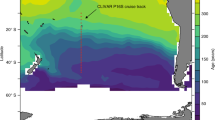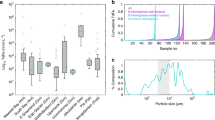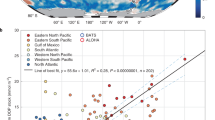Abstract
Increases in overall marine primary productivity and export production in high-nutrient, low-chlorophyll regions of the ocean have, particularly during dry and dusty glacial periods, been hypothesized to be linked to the enhanced delivery of iron1. In the modern ocean, iron availability limits production in high-nutrient, low-chlorophyll regions, and may be important in lower-nutrient settings as well2. Here, we assess the relationship between productivity and iron in sedimentary records from the high-nutrient, low-chlorophyll region of the equatorial Pacific Ocean over the past million years. We find strong links between iron input, the export and burial of biogenic silica (opal) and total export production. Our data demonstrate that iron accumulation was more closely tied to the accumulation of opal than any other biogenic component, with high iron input associated with substantially increased opal sedimentation. The strong links between iron and opal accumulation over the past one million years are in agreement with the modern biogeochemical behaviour of iron and silica, and the response of the diatom community to their mutual availablity3,4. Our data support earlier suggestions1 of a biological response to iron delivery over geologic timescales.
This is a preview of subscription content, access via your institution
Access options
Subscribe to this journal
Receive 12 print issues and online access
$259.00 per year
only $21.58 per issue
Buy this article
- Purchase on Springer Link
- Instant access to full article PDF
Prices may be subject to local taxes which are calculated during checkout




Similar content being viewed by others
References
Martin, J. H. Glacial–interglacial CO2 change: The iron hypothesis. Paleoceanography 5, 1–13 (1990).
Boyd, P. W. et al. Mesoscale iron enrichment experiments 1993–2005: Synthesis and future directions. Science 315, 612–617 (2007).
Brzezinski, M. A. et al. Co-limitation of diatoms by iron and silicic acid in the equatorial Pacific. Deep-Sea Res. 58, 493–511 (2011).
Marchetti, A. et al. Iron and silicic acid effects on phytoplankton productivity, diversity, and chemical composition in the central equatorial Pacific Ocean. Limnol. Oceanogr. 55, 11–29 (2010).
de Baar, H. J. W. et al. Synthesis of iron fertilization experiments: From the iron age in the age of enlightenment. J. Geophys. Res. 110, C09S16 (2005).
Ziegler, C. L., Murray, R. W., Plank, T. & Hemming, S. R. Sources of Fe to the equatorial Pacific Ocean from the Holocene to Miocene. Earth Planet. Sci. Lett. 270, 258–270 (2008).
Lyle, M. Bloom without fertilizer. Nature Geosci. 1, 576–578 (2008).
Murray, R. W., Leinen, M., Murray, D. W., Mix, A. C. & Knowlton, C. W. Terrigenous Fe input and biogenic sedimentation in the glacial and interglacial equatorial Pacific Ocean. Glob. Biogeochem. Cycles 9, 667–684 (1995).
Murray, R. W., Knowlton, C., Leinen, M., Mix, A. C. & Polsky, C. H. Export production and carbonate dissolution in the central equatorial Pacific Ocean over the past 1 Ma. Paleoceanography 15, 570–592 (2000).
Murray, J. W., Barber, R. T., Roman, M. R., Bacon, M. P. & Feely, R. A. Physical and biological controls on carbon cycling in the equatorial Pacific. Science 266, 58–65 (1994).
Paytan, A., Kastner, M. & Chavez, F. P. Glacial to interglacial fluctuations in productivity in the equatorial Pacific as indicated by marine barite. Science 74, 1355–1357 (1996).
Winckler, G., Anderson, R. F., Fleisher, M. Q., McGee, D. & Mahowald, N. Covariant glacial–interglacial dust fluxes in the equatorial Pacific and Antarctica. Science 320, 93–96 (2008).
Anderson, R. F., Fleisher, M. Q., Lao, Y. & Winckler, G. Modern CaCO3 preservation in equatorial Pacific sediments in the context of late-Pleistocene glacial cycles. Mar. Chem. 111, 30–46 (2008).
Hayes, C.T., Anderson, R.F. & Fleisher, M.Q. Opal accumulation rates in the equatorial Pacific and mechanisms of deglaciation. Paleoceanography 26, PA1207 (2011).
Farrell, J. W. & Prell, W. L. Climatic change and CaCO3 preservation: An 800,000 year bathymetric reconstruction from the central equatorial Pacific Ocean. Paleoceanography 4, 447–466 (1989).
Barber, R. T. & Hiscock, M. R. A rising tide lifts all phytoplankton: Growth response of other phytoplankton taxa in diatom-dominated blooms. Glob. Biogeochem. Cycles 20, GB4S03 (2006).
Murray, R. W. & Leinen, M. Chemical transport to the seafloor of the equatorial Pacific across a latitudinal transect at 135W; Tracking sedimentary major, trace, and rare earth element fluxes at the Equator and the Intertropical Convergence Zone. Geochim. Cosmochim. Acta 57, 4141–4163 (1993).
Lyle, M. et al. The record of late Pleistocene biogenic sedimentation in the eastern tropical Pacific Ocean. Paleoceanography 3, 39–59 (1988).
Marcantonio, F. et al. Sediment focusing in the central equatorial Pacific ocean. Paleoceanography 16, 260–267 (2001).
Thomas, E., Turekian, K. K. & Wei, K-Y. Productivity control of fine particle transport to equatorial Pacific sediment. Glob. Biogeochem. Cycles 14, 945–955 (2000).
Paytan, A., Lyle, M., Mix, A. & Chase, Z. Climatically driven changes in oceanic processes throughout the equatorial Pacific. Paleoceanography 19, PA4017 (2004).
Lyle, M. et al. Do geochemical estimates of sediment focusing pass the sediment test in the equatorial Pacific? Paleoceanography 20, PA1005 (2005).
Siddall, M. et al. Modeling the particle flux effect on distribution of 230Th in the equatorial Pacific. Paleoceanography 23, PA2208 (2008).
Broecker, W. Excess sediment 230Th: Transport along the sea floor or enhanced water column scavenging? Glob. Biogeochem. Cycles 22, GB1006 (2008).
Eppley, R. W. & Peterson, B. J. Particulate organic matter flux and planktonic new production in the deep ocean. Nature 282, 677–680 (1979).
Honjo, S., Dymond, J., Collier, R. & Manganini, S. J. Export production of particles to the interior of the equatorial Pacific Ocean during the 1992 EqPac experiment. Deep-Sea Res. 42, 831–870 (1995).
Archer, D., Lyle, M., Rodgers, K. & Froelich, P. What controls opal preservation in tropical deep-sea sediments? Paleoceanography 8, 7–21 (1993).
Dugdale, R. et al. The regulation of equatorial Pacific new production and pCO2 by silicate-limited diatoms. Deep-Sea Res. 58, 477–492 (2011).
Pollard, R. T. et al. Southern Ocean deep-water carbon export enhanced by natural iron fertilization. Nature 457, 577–581 (2009).
Acknowledgements
We thank R. F. Anderson (Lamont–Doherty Earth Observatory) for many discussions over the past years. Research initially supported by US NSF grant OCE9301097 to R.W.M. and M.L.
Author information
Authors and Affiliations
Contributions
R.W.M. carried out the original Fe analyses8, led and contributed to the writing of the manuscript and made essential and substantive contributions to the intellectual discussions. M.L. made essential and substantive contributions to the writing of the manuscript and the associated intellectual discussions, and supervised the master’s thesis research of C.W.K. C.W.K. carried out the original biogenic opal, CaCO3 and TOC analyses, and made essential and substantive contributions to the intellectual content of the manuscript.
Corresponding author
Ethics declarations
Competing interests
The authors declare no competing financial interests.
Supplementary information
Supplementary Information
Supplementary Information (PDF 1025 kb)
Rights and permissions
About this article
Cite this article
Murray, R., Leinen, M. & Knowlton, C. Links between iron input and opal deposition in the Pleistocene equatorial Pacific Ocean. Nature Geosci 5, 270–274 (2012). https://doi.org/10.1038/ngeo1422
Received:
Accepted:
Published:
Issue Date:
DOI: https://doi.org/10.1038/ngeo1422
This article is cited by
-
Equatorial Pacific dust fertilization and source weathering influences on Eocene to Miocene global CO2 decline
Communications Earth & Environment (2023)
-
Revisit of thorium-based dust fluxes and their implications for the iron fertilization hypothesis
Journal of Oceanography (2022)
-
Aerosol-Climate Interactions During the Last Glacial Maximum
Current Climate Change Reports (2018)
-
Millennial-scale iron fertilization of the eastern equatorial Pacific over the past 100,000 years
Nature Geoscience (2017)
-
No iron fertilization in the equatorial Pacific Ocean during the last ice age
Nature (2016)



